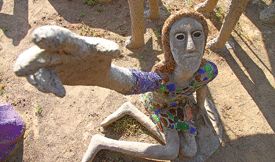Helen Martins, the story of an 'Outsider Artist'
Thalefang Charles
Staff Writer
| Friday October 21, 2011 00:00


Arts & Culture recently attended the Athol Fugard Festival at Nieu-Bethesda in the heart of the Great Karoo where we made our debut entrance to the real Owl House of Helen Martins.
In the book, Fugard presents 'Miss Helen' as unusual old Afrikaner woman living alone in a secluded little town creating odd concrete sculptures of owls, mermaids, wise men (people), camels and calling them her 'Mecca'. Due to fears of her 'idolatry' and her self-imposed exile from the Church, local pastor, Marius Byleveld wants to send her to some old-age home because he considers her 'art' public nuisance. The oddity of her artworks leads the whole community to believe that she has gone mad due to her husband's death. The attempts to move her to 'Old Folks' home is foiled with much needed support of Elsa - a young woman from Cape Town.
The Road To Mecca (the play) was performed in England and United States of America (US) and went on to win the New York Drama Critics Circle award for Best Foreign Play in 1988. When studying the book it is not easy to imagine the outlandishness of the real 'Miss Helen's art. Helen Martins is considered South Africa's foremost 'Outsider Artist'. Outsider Art or 'Art Brut' is a label given to an art produced by people not part of the conventional art world or art establishment. L'Art Brut was first coined by the French artist, Jean Dubuffet, in 1945. Dubuffet, psychiatric patients' art collector, defined 'Art Brut' as 'works executed by people free from artistic culture [who] draw up everything from their own depths and not from the stereotypes of classical art or of modish art, a 'chemically pure' artistic operation'.Her story is still being told today as her house has since been turned into a museum - her greatest wish. Helen Martins was born in December 1897, the youngest child of six and grew up in Nieu-Bethesda. She left her small town and went for her studies at Graaff-Reinet. After teaching spans in Transvaal, Cape Town and Port Elizabeth, and a failed marriage with a fellow teacher Willem Johannes Pienaar, Martins returned to her home town of Nieu-Bethesda to take care of her ailing elderly parents. Her mother died in 1941 and only four years later she lost her father too. At around 50 years she was left alone in the house in the boondocks of the Great Karoo with fewer prospects in her life. It is said that Martins 'became increasingly reclusive and isolated from the local community'.Isolated and alone, Miss Helen (as she was known among the residents) started to transform her modest house and garden into a remarkable, at times ghostly, works of art. It is reported that the predominately Christian community of Nieu-Bethesda responded to Martins' art with 'derision and suspicion'.
The story goes, Martins' eyesight began to fail her and eventually in 1976 she committed suicide by swallowing a mixture of caustic soda and crushed glass in olive oil because she could not bear the thought of going blind. Martins' great theme in her life and work is light and it is believed that she was worried that she would be taken away from the Owl House - her life's work.
After finally entering the Owl House, which still stands just the way Martins left it when she died in 1976, it is not hard to understand the community's rejection of Miss Helen's art. The Owl House is now a heritage art museum that is drawing hundreds of tourists to Nieu-Bethesda. Visitors to the museum are taken on a tour of the yard, which displays a kaleidoscope of cement sculptures - owls, camels, mermaids, sphinxes and people. Inside the house, where her unusual decorative quest began, Miss Helen used specially shaped mirrors, murals, candles, myriad lambs and crushed-glass which were coated on the walls, ceilings and windows to interplay her fascination of reflection, light and space.
According to museum curators, Martins employed Koos Malgas to help her make the cement-and - glass statues, which are standing on the Camel Yard outside the house. The Camel Yard, which was initially the garden is a sculpture yard of over 300 figures and animals. The sculptures are said to have been inspired by the Christian and Eastern philosophies, particularly the Bible and the writings of Omar Khayyam.
After spending time inside her house - now The Owl House Foundation Museum - you realise that it is understandably difficult to envisage the eeriness of 'Miss Helen' art from a written word but only until you visit the real Owl House of Helen Martins that inspired Athol Fugard would you comprehend.
Helen Martins undoubtedly immortalised Nieu-Bethesda. It is so remote yet it is now a small bustling home to a number of artists, crafters and other creatives who have since made it their 'Mecca'. Even though all the streets remain untarred, no petrol station and no bank there is however a bookshop. It hosts the annual Athol Fugard Festival, attracting a decent crowd of literature lovers and artists for week-long activities of music, theatre, shows, exhibitions and most significantly celebrating the man who immortalised both Helen Martins and Nieu-Bethesda - Athol Fugard.
